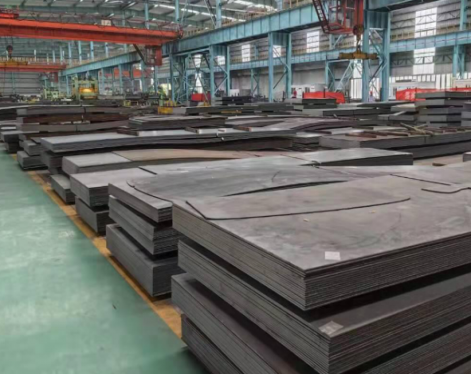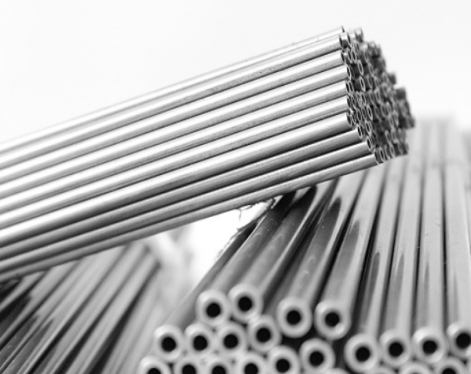Hot-rolled steel plates and cold-rolled steel plates are two common steel products. The difference between them lies in the different production processes, as follows:
1. Production temperature
Hot-rolled steel plates are produced at high temperatures, usually above 1000 degrees Celsius, which makes the steel more plastic and easy to form into the desired shape. However, a layer of iron oxide scale is formed on the surface of the steel during the hot rolling process, which needs to be removed in subsequent processing. The strength and hardness of hot-rolled steel plates are relatively low, but the elongation and toughness are high, which is suitable for occasions requiring high plasticity and toughness, such as buildings, bridges, etc.
Cold-rolled steel plates are produced at room temperature, so their precision and surface quality are higher. The raw material of cold-rolled steel plates is hot-rolled plates or steel strips. Due to the low rolling temperature, the internal organization and structure of the steel are more compact, resulting in higher strength and hardness, but lower elongation and toughness. Cold-rolled steel plates have good surface quality and are often used in products with high precision and surface requirements, such as automobile bodies, home appliance housings, etc.

2. Surface finish
Because hot-rolled steel plates are produced at high temperatures, their surfaces are relatively rough and have defects such as scale; while cold-rolled steel plates have relatively smooth surfaces and no defects such as scale.
3. Mechanical properties
Due to different production processes, the mechanical properties of hot-rolled and cold-rolled steel plates are also different. The mechanical properties of hot-rolled steel plates are better than those of cold-rolled steel plates, especially in terms of strength and plasticity. Generally speaking, hot-rolled steel plates have higher strength and toughness, but poorer plasticity; while cold-rolled steel plates have better plasticity, but relatively lower strength and toughness.
Because hot-rolled steel plates require high temperatures during processing, their grain size is also larger and their crystal structure is looser, which makes them have better toughness and plasticity. Cold-rolled steel plates, on the other hand, are processed at room temperature, so their grain size is smaller and their crystal structure is more compact, so their strength and hardness are higher.
4. Different uses
Due to differences in mechanical properties and surface finish, hot-rolled and cold-rolled steel plates are also used in different occasions. Hot-rolled steel plates are widely used in construction, bridges, ships and other fields due to their good plasticity and toughness. Cold-rolled steel plates are mainly used to manufacture products with high precision requirements due to their high strength and good surface quality.
How to choose hot-rolled and cold-rolled steel plates?
From the perspective of daily selection, the following methods are generally used to select:
1. Appearance and surface quality
Since cold plates are obtained from hot plates after the cold rolling process, and some surface finishing is also performed during cold rolling, the surface quality (such as surface roughness) of cold plates is better than that of hot plates. Therefore, if there are high requirements for the quality of subsequent coating such as painting, cold plates are generally selected. In addition, hot plates are divided into pickled plates and unpickled plates. The surface of pickled plates has a normal metallic color due to pickling, but the surface is not as high as that of cold plates because they are not cold rolled. Unpickled plates usually have an oxide layer on the surface, which is black, or there is a black layer of ferroferric oxide.
2. Performance
Generally speaking, the mechanical properties of hot plates and cold plates are considered to be the same in engineering. Although cold plates undergo a certain degree of work hardening during the cold rolling process (but this does not rule out the situation where strict mechanical properties are required, which requires different treatment), cold plates usually have a slightly higher yield strength and surface hardness than hot plates.
3. Production process
Hot rolling is rolling a steel plate at a higher temperature into a relatively thinner steel plate; cold rolling is rolling a steel plate at room temperature. Generally, hot rolling is performed first, followed by cold rolling. When the steel plate is thick, hot rolling can only be used. After rolling into a thinner plate, cold rolling is performed. Hot-rolled steel plates are divided into thick plates (thickness greater than 4mm) and thin plates (thickness 0.35~4mm); cold-rolled steel plates only have thin plates (thickness 0.2~4mm). The termination temperature of hot rolling is generally 800~900℃, and then it is generally cooled in air, so the hot rolling state is equivalent to normalizing treatment. Metal materials delivered in hot-rolled state have a certain degree of corrosion resistance because their surface is covered with a layer of oxide film.
1. Production temperature
Hot-rolled steel plates are produced at high temperatures, usually above 1000 degrees Celsius, which makes the steel more plastic and easy to form into the desired shape. However, a layer of iron oxide scale is formed on the surface of the steel during the hot rolling process, which needs to be removed in subsequent processing. The strength and hardness of hot-rolled steel plates are relatively low, but the elongation and toughness are high, which is suitable for occasions requiring high plasticity and toughness, such as buildings, bridges, etc.
Cold-rolled steel plates are produced at room temperature, so their precision and surface quality are higher. The raw material of cold-rolled steel plates is hot-rolled plates or steel strips. Due to the low rolling temperature, the internal organization and structure of the steel are more compact, resulting in higher strength and hardness, but lower elongation and toughness. Cold-rolled steel plates have good surface quality and are often used in products with high precision and surface requirements, such as automobile bodies, home appliance housings, etc.

2. Surface finish
Because hot-rolled steel plates are produced at high temperatures, their surfaces are relatively rough and have defects such as scale; while cold-rolled steel plates have relatively smooth surfaces and no defects such as scale.
3. Mechanical properties
Due to different production processes, the mechanical properties of hot-rolled and cold-rolled steel plates are also different. The mechanical properties of hot-rolled steel plates are better than those of cold-rolled steel plates, especially in terms of strength and plasticity. Generally speaking, hot-rolled steel plates have higher strength and toughness, but poorer plasticity; while cold-rolled steel plates have better plasticity, but relatively lower strength and toughness.
Because hot-rolled steel plates require high temperatures during processing, their grain size is also larger and their crystal structure is looser, which makes them have better toughness and plasticity. Cold-rolled steel plates, on the other hand, are processed at room temperature, so their grain size is smaller and their crystal structure is more compact, so their strength and hardness are higher.
4. Different uses
Due to differences in mechanical properties and surface finish, hot-rolled and cold-rolled steel plates are also used in different occasions. Hot-rolled steel plates are widely used in construction, bridges, ships and other fields due to their good plasticity and toughness. Cold-rolled steel plates are mainly used to manufacture products with high precision requirements due to their high strength and good surface quality.
How to choose hot-rolled and cold-rolled steel plates?
From the perspective of daily selection, the following methods are generally used to select:
1. Appearance and surface quality
Since cold plates are obtained from hot plates after the cold rolling process, and some surface finishing is also performed during cold rolling, the surface quality (such as surface roughness) of cold plates is better than that of hot plates. Therefore, if there are high requirements for the quality of subsequent coating such as painting, cold plates are generally selected. In addition, hot plates are divided into pickled plates and unpickled plates. The surface of pickled plates has a normal metallic color due to pickling, but the surface is not as high as that of cold plates because they are not cold rolled. Unpickled plates usually have an oxide layer on the surface, which is black, or there is a black layer of ferroferric oxide.
2. Performance
Generally speaking, the mechanical properties of hot plates and cold plates are considered to be the same in engineering. Although cold plates undergo a certain degree of work hardening during the cold rolling process (but this does not rule out the situation where strict mechanical properties are required, which requires different treatment), cold plates usually have a slightly higher yield strength and surface hardness than hot plates.
3. Production process
Hot rolling is rolling a steel plate at a higher temperature into a relatively thinner steel plate; cold rolling is rolling a steel plate at room temperature. Generally, hot rolling is performed first, followed by cold rolling. When the steel plate is thick, hot rolling can only be used. After rolling into a thinner plate, cold rolling is performed. Hot-rolled steel plates are divided into thick plates (thickness greater than 4mm) and thin plates (thickness 0.35~4mm); cold-rolled steel plates only have thin plates (thickness 0.2~4mm). The termination temperature of hot rolling is generally 800~900℃, and then it is generally cooled in air, so the hot rolling state is equivalent to normalizing treatment. Metal materials delivered in hot-rolled state have a certain degree of corrosion resistance because their surface is covered with a layer of oxide film.









